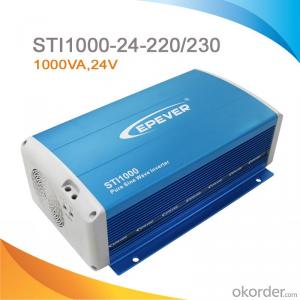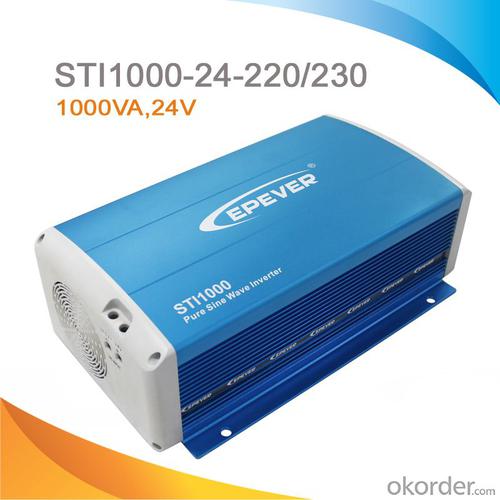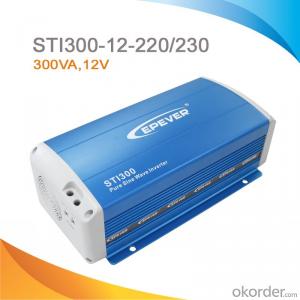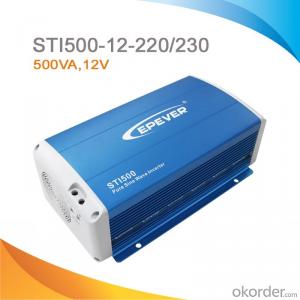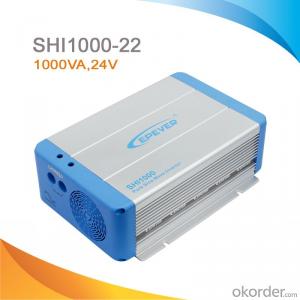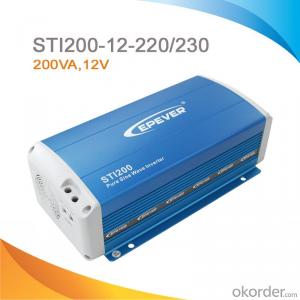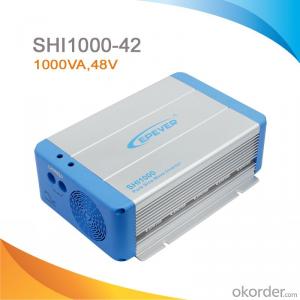STI 1000W Frequency Pure Sine Wave Inverter DC 24V to AC 220V/230V,STI1000
- Loading Port:
- China Main Port
- Payment Terms:
- TT or LC
- Min Order Qty:
- -
- Supply Capability:
- -
OKorder Service Pledge
OKorder Financial Service
You Might Also Like
Description
STI series is a sine wave power frequency inverter which can convert 12V or 24V DC to 220VAC or 230VAC 50Hz based on full digital and intelligent design. The inverter can be applied in many fields especially for solar photovoltaic power system.

Features:
·Complete isolation-type inverter technology, noiseless output
·Adoption of advanced SPWM technology, pure sine wave output
·Dynamic current loop control technology to ensure inverter reliable operation.
·Wide DC input voltage range
·Excellent EMC design
·Low output harmonic distortion(THD≤3%)
·LED indicators display input voltage range, load power range, normal output & failure state
·Optional energy saving mode
·Wide working temperature range (industrial level)
·Continuous operation at full power
Protections:
·Output Short Circuit protection
·Overload protection
·Input reverse polarity protection
·Input low voltage protection
·Input over voltage protection
·Inverter abnormal protection
·Overheating protection
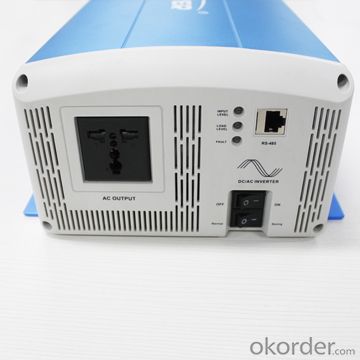
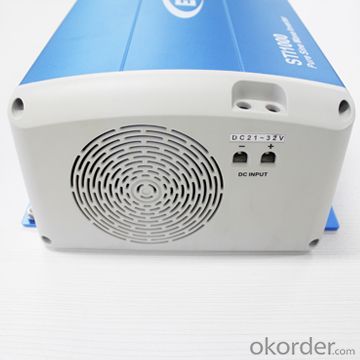
Specification:
Types | SHI1000-22 | SHI1000-42 |
Nominal Battery Voltage | 24V | 48V |
Input Voltage Range | 21.6~32Vdc | 43.2~64Vdc |
No Load Current | ≤0.45A | ≤0.35A |
Output Wave | Pure Sine Wave | |
Output Voltage | 220Vac±3% / 230Vac±10% | |
Continuous Power | 1000W | |
Power 10 sec | 1500W | |
Power 1.5 sec | 2000W | |
Surge Power | 2250W | |
Frequency | 50/60Hz±0.2% | |
Distortion THD | ≤ 3% (resistive load) | |
Efficiency at Rated Power | ≥93% | ≥93.5% |
Max. Efficiency | ≥94% | ≥94% |
Terminal | 25mm2 | |
Dimensions | 295×208×98mm | |
Installation | 150×200mm | |
Hole Size | Φ6mm | |
Net Weight | 3.3kg | |
Working Temperature | -20℃~ +50℃ | |
Storage Temperature | -35℃~ +70℃ | |
Humidity | < 95% (N.C.) | |
Altitude | < 5000m(Derating to operate according to IEC62040 at a height exceeding 1000m) | |
Insulation Resistance | Between DC input terminals and metal case: ≥550MΩ; Between AC output terminals and metal case: ≥550MΩ. | |
Dielectric Strength | Between DC input terminals and metal case: Test voltage AC1500V, 1 minute Between AC output terminals and metal case: Test voltage AC1500V, 1 minute | |
FAQ
Central inverter and String inverter Comparison
In terms of money, string inverters will get more and more expensive vs central inverters as the field size increases. It's a heck of a lot of additional labor to hook up 100 string inverters of 10kW vs. 3 or 4 central inverters (which can also be bought in pre-configured 1MW units with some of the connections already done).
Personally, I would draw the line around 250 - 400 kW. Below that string inverters work out well. Above that central inverters have their place (and will save money). Can it be made to work either way, and work well? Sure!
- Q: What is the role of a solar inverter in a solar-powered water purification system?
- The role of a solar inverter in a solar-powered water purification system is to convert the direct current (DC) generated by the solar panels into alternating current (AC) that can be used to power the water purification system. This conversion allows for the efficient operation of the system, ensuring a continuous supply of purified water using solar energy.
- Q: What is the purpose of a solar inverter in a solar power system?
- The purpose of a solar inverter in a solar power system is to convert the direct current (DC) electricity produced by solar panels into alternating current (AC) electricity, which is the type of electricity used in most household appliances and the power grid.
- Q: Can a solar inverter be used with battery storage?
- Yes, a solar inverter can be used with battery storage. In fact, it is commonly used in solar energy systems to convert the direct current (DC) power generated by solar panels into alternating current (AC) power that can be used by household appliances or stored in batteries for later use. The solar inverter plays a crucial role in managing the flow of electricity between the solar panels, batteries, and the electrical grid, ensuring efficient energy utilization and storage.
- Q: How do you calculate the maximum power point current for a solar inverter?
- To calculate the maximum power point current for a solar inverter, you need to determine the optimal operating voltage and current at which the solar panel can produce the maximum power. This can be done by using a technique known as the perturb and observe (P&O) algorithm. The P&O algorithm continuously adjusts the operating point of the solar panel by slightly perturbing the voltage and observing the resulting change in power. By tracking the voltage and current values that yield the highest power output, you can calculate the maximum power point current for the solar inverter.
- Q: What are the potential risks of short-circuiting a solar inverter?
- Short-circuiting a solar inverter can pose several potential risks. Firstly, it can cause damage to the inverter itself, leading to its malfunction or complete failure. Secondly, it can result in overheating of the inverter, which may increase the risk of fire or electrical hazards. Additionally, short-circuiting can disrupt the flow of electricity, potentially causing damage to other connected equipment or appliances. Lastly, it may void the warranty of the solar inverter, resulting in additional expenses for repairs or replacements. Therefore, it is crucial to take proper precautions and avoid short-circuiting the solar inverter to ensure its safe and efficient operation.
- Q: What is the importance of insulation resistance measurement in a solar inverter?
- Insulation resistance measurement in a solar inverter is crucial as it helps ensure the safety and efficiency of the electrical system. By measuring the insulation resistance, any potential faults or deteriorations in the insulation can be detected, preventing electrical leakage or short circuits. This measurement also helps identify any insulation breakdowns that may compromise the performance and reliability of the solar inverter. Ultimately, insulation resistance measurement is essential for maintaining the integrity of the solar inverter and ensuring the safety of both the electrical system and the people using it.
- Q: Can a solar inverter be connected to a smart home or monitoring system?
- Yes, a solar inverter can be connected to a smart home or monitoring system. This integration allows for real-time monitoring, remote control, and data analysis of the solar energy production and consumption within a smart home or monitoring system.
- Q: What is the maximum number of solar panels that can be connected to a single inverter?
- The maximum number of solar panels that can be connected to a single inverter depends on the inverter's capacity and the specifications provided by the manufacturer. It can vary widely based on factors such as the wattage rating of the inverter, the voltage and current output of the solar panels, and the electrical compatibility between them. It is important to consult the manufacturer's guidelines or seek professional advice to determine the appropriate number of panels for a specific inverter.
- Q: Can a solar inverter be used in remote locations?
- Yes, solar inverters can be used in remote locations. They are designed to convert the direct current (DC) generated by solar panels into alternating current (AC) that can be used to power electrical devices. Solar inverters are versatile and can be installed and operated in various settings, including remote locations where grid electricity is not available. These inverters allow for the utilization of solar energy in off-grid areas, making them an ideal choice for powering remote homes, cabins, or other facilities.
- Q: What is the temperature range for optimal operation of a solar inverter?
- The temperature range for optimal operation of a solar inverter typically falls between -20°C to 50°C.
Send your message to us
STI 1000W Frequency Pure Sine Wave Inverter DC 24V to AC 220V/230V,STI1000
- Loading Port:
- China Main Port
- Payment Terms:
- TT or LC
- Min Order Qty:
- -
- Supply Capability:
- -
OKorder Service Pledge
OKorder Financial Service
Similar products
Hot products
Hot Searches
Related keywords
